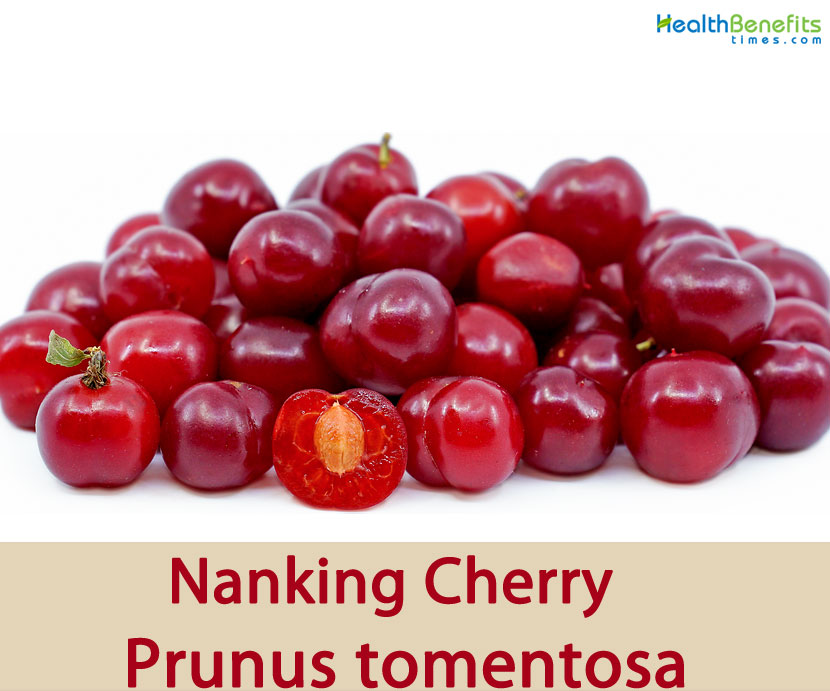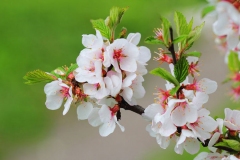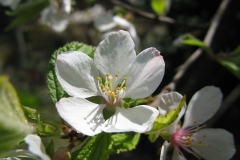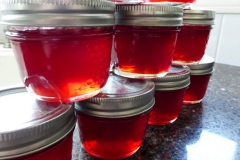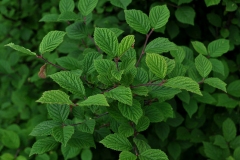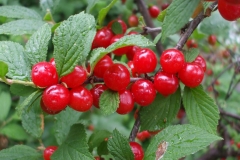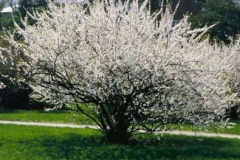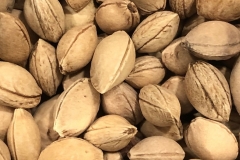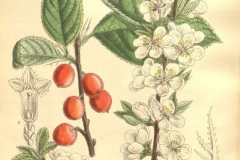| Nanking cherry Quick Facts | |
|---|---|
| Name: | Nanking cherry |
| Scientific Name: | Prunus tomentosa |
| Origin | Northern and western China (including Tibet), Korea, Mongolia, and possibly northern India |
| Colors | Pale pink to bright cherry red |
| Shapes | Small fruits, only 1- 2 centimeters in diameter, cherry shaped, and with a large pit inside |
| Taste | Sweet but slightly tart |
| Health benefits | Beneficial for respiration, digestion, cancer and uric acid levels in the blood |
| Name | Nanking cherry |
|---|---|
| Scientific Name | Prunus tomentosa |
| Native | Northern and western China (including Tibet), Korea, Mongolia, and possibly northern India (Jammu and Kashmir, though probably only cultivated there) and naturalized in Japan, Russia, and other northern regions of the continent. It has become a staple back yard garden plant in Russia and much of Eastern Europe |
| Common Names | Nanjing cherry, Korean cherry, Manchu cherry, downy cherry, Shanghai cherry, Ando cherry, mountain cherry, Chinese bush cherry, Chinese dwarf cherry, Mongolian cherry, Aengdo, Aengdonamu, Mao Yingtao, Maotao, Maoyingtao, Yeyingtao, Yusura ume, Luddkörsbär, Japanische Mandelkirsche, Cerisier Tomenteux |
| Name in Other Languages | Azerbaijani: Keçəli albalı Bengali: Nānakiṁ cēri (নানকিং চেরি) Breton: Gwez-ragoumin Chinese: Mao ying tao (毛樱桃), Mei t’ao Croatian: Nankinška trešnja Danish: Mandshurisk kirsebaer Dutch: Viltkers English: Manchu bird cherry, Mandchu cherry, Manchu cherry, Nanking cherry, Korean cherry, Downy cherry, Ando cherry, Chinese bush cherry, Chinese Dwarf Cherry, Mongolian Cherry, mountain cherry, Shanghai Cherry Estonian: Vilt-kirsipuu Finnish: Nukkakirsikka French: Cerisier tomenteux, Ragouminier German: Japanische Mandelkirsche, japanische Kirschmandel, Korea-Kirschbaum Japanese: Yusura ume (ユスラウメ), Manshuu cherii, Manshuu cherii, Manshuu cherii, Japanische Mandelkirsche Korean: Aengdunamu (앵두나무), aeng do (앵도) Lithuanian: Veltininė vyšnia Persian: گیلاس کرهای Russian: Vishnia voilochnaia (вишня войлочная) Serbian: Japanska dlakava višnja (јапанска длакава вишња) Swedish: Luddkörsbär Ukrainian: Vishnya postistina (Вишня повстиста) Vietnamese: Anh đào núi |
| Plant Growth Habit | Broadly spreading, twiggy, hardy, deciduous shrub |
| Growing Climates | Slopes, in ravines, Forest on mountain slopes, forest margins, thickets and meadows |
| Soil | Flourishes in well-drained, slightly acidic soil |
| Plant Size | 100 – 200 cm tall and around twice as wide. It rarely becomes more tree-like and can then grow up to 300 cm tall |
| Bark | Glabrous, copper-tinted black and exfoliating when mature |
| Leaf | Alternate, 2–7 cm long and 1–3.5 cm broad, oval to obovate, acuminate with irregularly serrate margins, rugose, dark green, pubescent above and tomentose below, with glandular petioles |
| Flowering season | March to April |
| Flower | White or pink in a scarlet calyx, opening with or before the leaves in spring. They are reliably profuse, arranged in clusters on scarlet pedicels and are 1.5–2.0 cm in diameter |
| Fruit Shape & Size | Small fruits, only 1- 2 centimeters in diameter, cherry shaped, and with a large pit inside |
| Fruit Color | Pale pink to bright cherry red skin |
| Fruit Color | Shiny and smooth |
| Propagation | By seed, softwood cuttings or root suckers |
| Taste | Sweet but slightly tart |
| Lifespan | With proper care and maintenance, they can live up to 50 years. Without care, plants have reportedly lived 20 years or more |
| Season | July |
| Precautions |
|
Plant Description
Nanking cherry is a broadly spreading, twiggy, hardy, deciduous shrub that normally grows about 100 – 200 cm tall and around twice as wide. It rarely becomes more tree-like and can then grow up to 300 cm tall. The plant is found growing in slopes, in ravines, forest on mountain slopes, forest margins, thickets and meadows. The plant flourishes in well-drained, slightly acidic soil. Plants grown from seed may develop a deep taproot, and are very drought tolerant after initial establishment. Bark is glabrous, copper-tinted black and exfoliating when mature.
Leaves
Nanking leaves are elliptical, alternate 2–7 cm long and 1–3.5 cm broad, oval to obovate, acuminate, with irregularly serrated edges alternating on stems. They are deeply veined, and are also covered with white, downy fuzz especially on the pale underside which is the origin of one of its common names of ‘downy cherry’. It is dark green, pubescent above and tomentose below, with glandular petioles.
| Bud Arrangement | Alternate |
| Bud Color | Brown |
| Bud Size | 1/8 inch |
| Leaf Type and Shape | Simple, elliptical |
| Leaf Margins | Unequally serrate |
| Leaf Surface | Rough-veined, pubescent |
| Leaf Length | 2 to 3 inches |
| Leaf Width | 1 to 1½ inches |
| Leaf Color | Medium to dark green above; white hairs below; yellow fall color |
Flowers
These darling buds of May are one of the great pleasures of spring. The Nanking blossoms appear in our yard around the second week of May, before the leaves have emerged. The flowers are white or pink in a scarlet calyx, opening with or before the leaves in spring. They are reliably profuse, arranged in clusters on scarlet pedicels and are 1.5–2.0 cm in diameter. Flowers are very frost tolerant.
| Flower Type | Small but numerous |
| Flower Color | Pink in bud, becoming near white |
| Fruit Type | Cherry-shaped drupe |
| Fruit Color | Dark red |
Fruit
Nanking cherry bushes need another Prunus plant to pollinate them. In other words you’ll need to have another Nanking cherry nearby, or any type of cherry, or a plum, or an apricot, and so on. This is currently our biggest hindrance to fruit set.
The clusters of fruit are nestled in among the leaves, spaced out at intervals along the branches. Nanking cherries are quite small, measuring 1- 2 centimeters in diameter (about the size of a blueberry). Their pale pink to bright cherry red skin is shiny and smooth, and the pulp is juicy. Each fruit contains one seed, much like other cherries. Nanking cherries are sweet and tart.
Unlike the image of cherries that most of us have in our brains, Nankings are connected to the branches of the shrub by very short stalks. They do not grow in the drooping clusters, but rather in lines up and down the length of the branches.
Health Benefits of Nanking Cherry
Listed below are some of the health benefits of using Nanking cherry
Promote Hair Growth
Earlier research had found that Nanking cherry has protective action on skin tissues and its subsidiary organs. It has also shown a strong role in promoting hair growth.
When Prunus tomentosa thumb total flavone (PTTTF) was continuously used on external local parts of phalacrosis mouse models. It was discovered that PTTTF had significantly promoted the hair growth cycle and follicle maturation. However more research is required.
Anticancer Activity
Research shows that phenylpropanoid sucrose esters, isolated from leaves of Nanking cherry have shown cytotoxic activity against four human cancer cell lines tested.
The cytotoxic activity of these isolates was stronger when compared with the positive control 5-fluorouracil used. The results also indicate these isolates might be a promising source for anti-cancer drug candidates.
Anti-oxidant and Inhibitory Activity
Nanking cherry seeds consist of flavonoids that are known to exhibit antioxidant activity.
Research had also revealed that flavonoids present in the seed extract of Nanking cherry were able to exhibit Antioxidant and Inhibitory activity on Nitric oxide and prostaglandin E2 production.
The DPPH radical scavenging assay had also shown that the antioxidant activity of some of the flavonoids was also higher than the positive control, Ascorbic acid.
Works against frostbites
Research conducted to know the effect of Prunus tomentosa thumb total flavone on frostbite had proven that, PTTTF has significant anti-frostbite effect.
Research also said that the total flavone can inhibit the MMP9 expression in frostbite tissues and IL-1β in peripheral blood mononuclear cells to relieve the inflammation caused by frostbite.
Traditional uses and benefits of Nanking cherry
- In small quantities, hydrogen cyanide has been shown to stimulate respiration and improve digestion, it is also claimed to be of benefit in the treatment of cancer.
- In small amounts this exceedingly poisonous compound stimulates respiration, improves digestion and gives a sense of well-being.
- The fruit can also help lower uric acid levels in the blood, which can result in gout.
Culinary Uses
- Fruit can be consumed raw or cooked.
- The unripe fruits can be pickled.
- Seed can be consumed raw or cooked.
- The buds are cooked and eaten.
- Leaves are used for pickling of vegetables and mushrooms.
- Fruit is edible, being an ingredient of juice, jam, and wine, and in pickled vegetables and mushrooms.
- Nanking cherries are eaten fresh or used to make pies, jams and jellies.
- Use Nanking cherries to flavor vinegar or pickle unripe fruits.
- Fruits are processed into wine, syrup, jellies and pies.
Other Facts
- A green dye can be obtained from the leaves.
- A dark grey to green dye can be obtained from the fruit.
- It is an excellent windbreak hedgerow.
- Plants produce suckers freely.
- Flowers are pinkish – white fragrant that attract lot of beneficial insects.
- In Manchuria and the Midwest United States, the shrub is planted in hedgerows to provide a windbreak.
- The plant produces fruits after 3 years when grown from seed.
References:
https://www.itis.gov/servlet/SingleRpt/SingleRpt?search_topic=TSN&search_value=504627#null
https://npgsweb.ars-grin.gov/gringlobal/taxon/taxonomydetail?id=30138
https://pfaf.org/user/Plant.aspx?LatinName=Prunus+tomentosa
http://www.missouribotanicalgarden.org/PlantFinder/PlantFinderDetails.aspx?taxonid=286358
https://plants.usda.gov/home/plantProfile?symbol=PRTO80
http://www.narc.gov.jo/gringlobal/taxonomydetail.aspx?id=30138
https://www.cabi.org/isc/datasheet/44369
https://plants.ces.ncsu.edu/plants/prunus-tomentosa/
https://gd.eppo.int/taxon/PRNTO
http://www.theplantlist.org/tpl1.1/record/rjp-3246
https://en.wikipedia.org/wiki/Prunus_tomentosa
https://www.ag.ndsu.edu/trees/handbook/th-3-11.pdf


